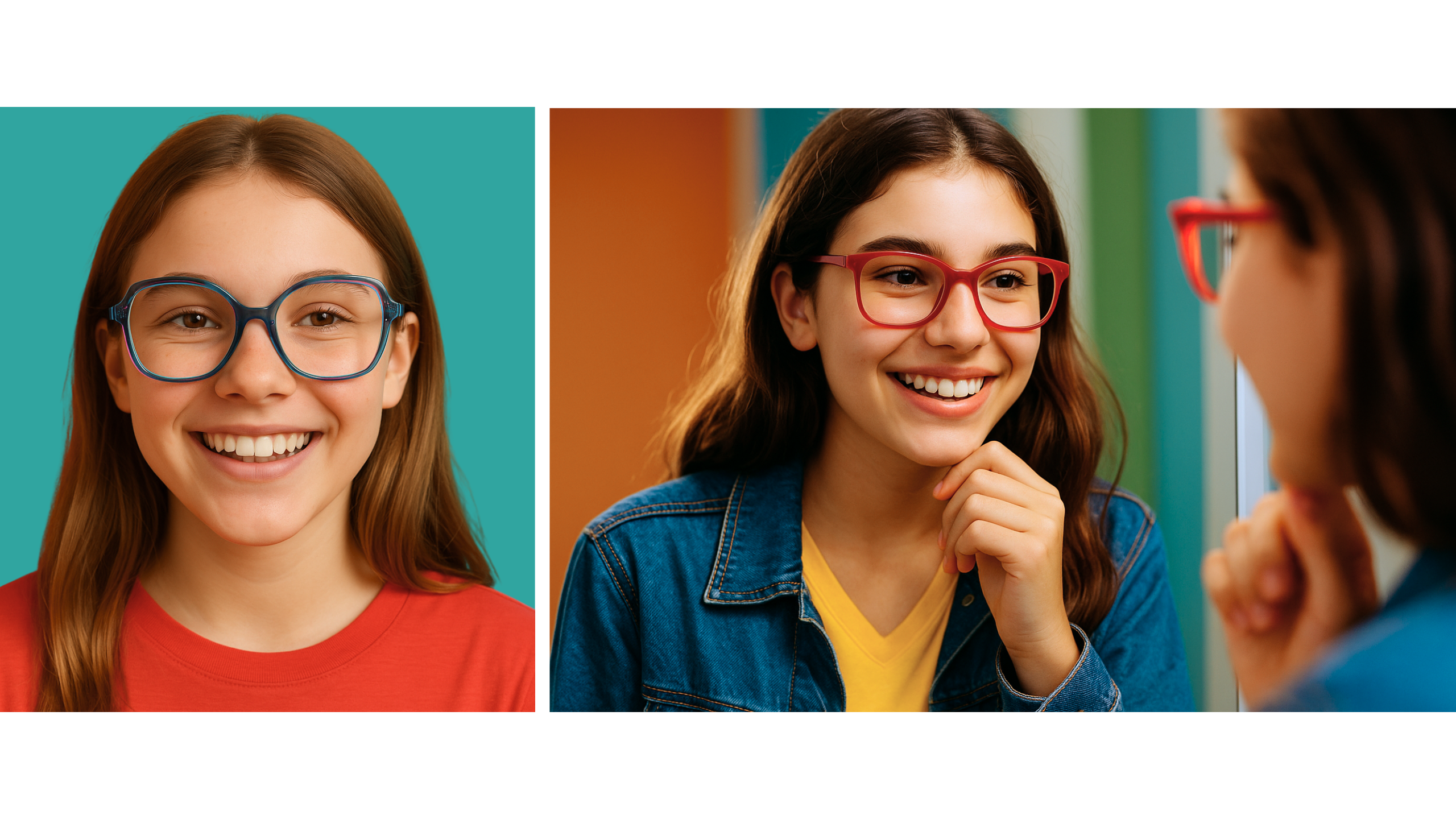👓 From “necessity” to “identity”: how children and teens see — and are seen — differently
Once upon a time, glasses were “for those who couldn’t see well.”
Today, they’re much more than that: a design accessory that tells your story — even when you’re only eight or fourteen.
In the past few decades, eyewear has evolved dramatically — and the biggest revolution happened where few expected it: in the world of the young.
Because yes, kids and teens want to feel unique, confident… and cool in their glasses.
🌈 From “big and boring” to smiles behind the lenses
Not long ago, children’s eyewear was made mainly to work: sturdy, maybe colorful, but not stylish.
Now, the key word is style.
New generations grow up in a world where image matters — and glasses can no longer feel imposed; they must become allies.
Light shapes, flexible materials, vibrant colors and imaginative details: every frame is designed to match a personality, not just a prescription.
Glasses are no longer a “sign of weakness” — they’re a visual superpower.
💪 Design in motion: where technology meets personality
In junior design, everything has changed.
From durability to freedom of movement, from lightness to bio-based materials — every detail is made for those who explore life with curious eyes and lively hands.
• Sturdy acetate and lightweight metal for endless adventures.
• Strong hinges and adjustable temples that grow with the face.
• Transparent, glossy, bold colors full of energy — for kids who already want to choose their own style.
• Smart lenses that protect from blue light and UV rays — perfect for digital natives.
Function and style have finally found balance — creating eyewear that grows with you.
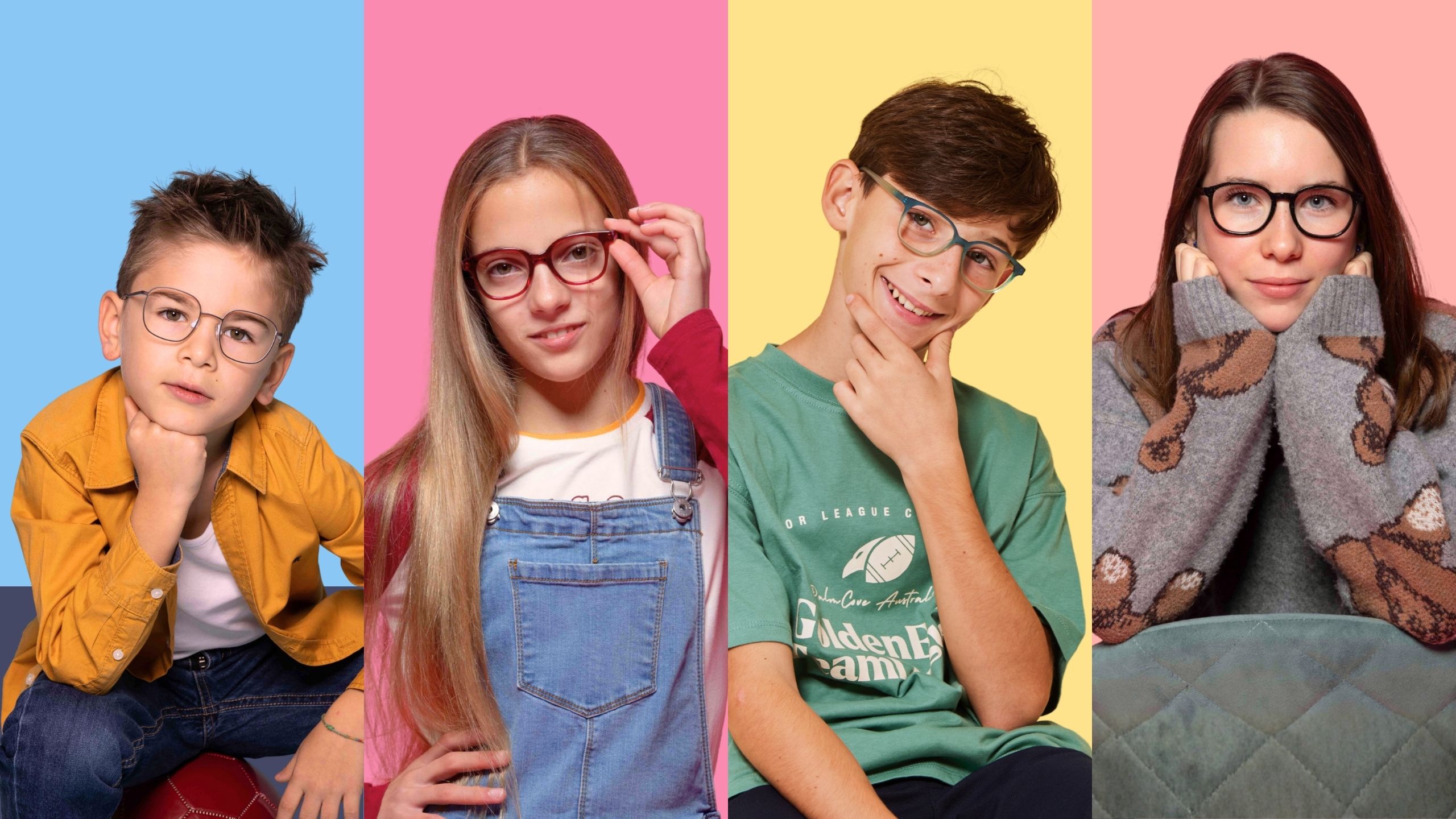
👦👧 From little explorers to teens with attitude
Design evolution mirrors the growth of those who wear it.
Kids look for comfort, lightness, freedom. Teens want personality and confidence.
The result? Frames inspired by timeless classics — reinterpreted with a pop, urban, and playful twist.
Glasses become true fashion accessories, taking cues from music, sport and social culture.
And for those who prefer simplicity: minimal design, clean lines, subtle details — essential, yet full of character.
Each model speaks its own language, but carries the same message: seeing well means feeling good.
🔍 The optician as a “curator of style”
Today, the optician is more than a technician — they’re a curator of visual experiences.
Families and young customers seek advice, but also emotion.
They want glasses that work, but also inspire — and last.
The new role of the optician is to translate technique into feeling: explaining materials, sharing design stories, and highlighting brands that combine craftsmanship and creativity for the next generation.
Because the right pair of glasses can change how a child sees the world — and how they see themselves.
🚀 The future: personality, sustainability and freedom of expression
Glasses are becoming a statement of identity — small design objects that evolve with a changing world.
While technology keeps advancing, the goal stays the same: helping young people see better and be seen better.
❤️ Because every growing gaze deserves great design
The evolution of eyewear is a story of creativity, ingenuity and care.
But when it comes to children and teens, it’s also about trust, freedom and self-expression.
That’s why we no longer talk about “kids’ glasses,” but about eyewear made to grow beautifully — with color, lightness and authenticity.



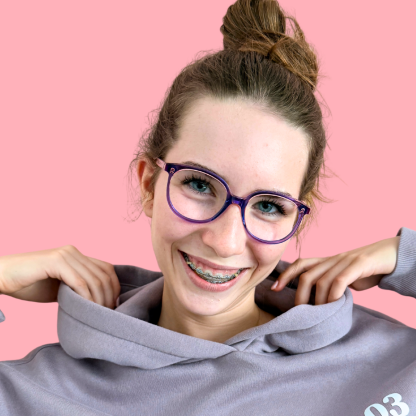

⏱️ 04:10 READING TIME
Teen glasses: why opticians play a key role in growing up .
“I don’t want kids’ glasses anymore.” – The moment everything changes
t can happen when a frame breaks, or simply when it’s time for a new one.
A 12-, 13- or 14-year-old sits in front of the optician’s mirror and, for the first time, looks differently at the glasses they’ve always worn without much thought.
Now it’s not enough that they just fit.
They need to say something. About him. About her. About the person they’re becoming.
And that’s when you hear it:
“I don’t want kids’ glasses anymore.”
👓 Glasses as part of identity
In childhood, glasses are usually chosen by parents: durability, practicality, maybe a splash of color.
But around 12 or 13, things change.
The body changes. The mind changes. The way a young person sees themselves changes.
And glasses take on a new role: no longer just a medical device, but part of their identity.
A calling card.
A way of saying to the world:
“Look at me. This is who I am.”
The challenge? The market often doesn’t offer the right answer. Opticians are usually left with two extremes:
- 👶 Kids’ glasses: too colorful, childish, not right for their new identity
- 🧓 Adult glasses: oversized, out of place, not made for young faces
And those in between?
Those who are still shaping their identity, caught between two worlds?
They’re often left without options.
🧠 The optician’s (and parent’s) role is crucial
At this stage, the optician is more than just a technician: they become a key figure in shaping self-image.
A skilled, up-to-date and empathetic optician can turn a potential crisis into a growth moment.
They can listen, understand, and guide with empathy toward the right choice.
But something more is needed:
✔️ A collection designed specifically for teens
✔️ Communication that includes real listening
✔️ The ability to offer a respectful, non-condescending alternative
Parents, too, need to strike a balance between functionality and their child’s genuine desire to express themselves through what they wear.
🎯 What do teens really want?
They don’t want “adult” glasses. They want glasses that fit this stage of life.
Frames with a mature style, but designed for them:
for features still developing, for a dynamic lifestyle, for their craving for freedom and authenticity.
And this demand shouldn’t be ignored—it’s also a big opportunity for forward-thinking opticians.
✨ The teen segment isn’t “just transitional”. It’s a real opportunity.
Too often, teenagers are seen as “in-between customers.”
But winning them over now—with the right product and a positive experience—can create loyalty for years to come.
Investing in this age group means:
- Building trust with the whole family
- Offering a real and under-served alternative
- Standing out from those who only offer compromises
❤️ A fresh vision for a new generation
We believe teenagers deserve frames that make them feel represented.
Not treated like children.
Not forced to look like adults.
But seen, heard, respected.
The right glasses for a teenager say: “You’re exactly where you should be. And you’re doing great.”
And those who can offer them… will truly make the difference.
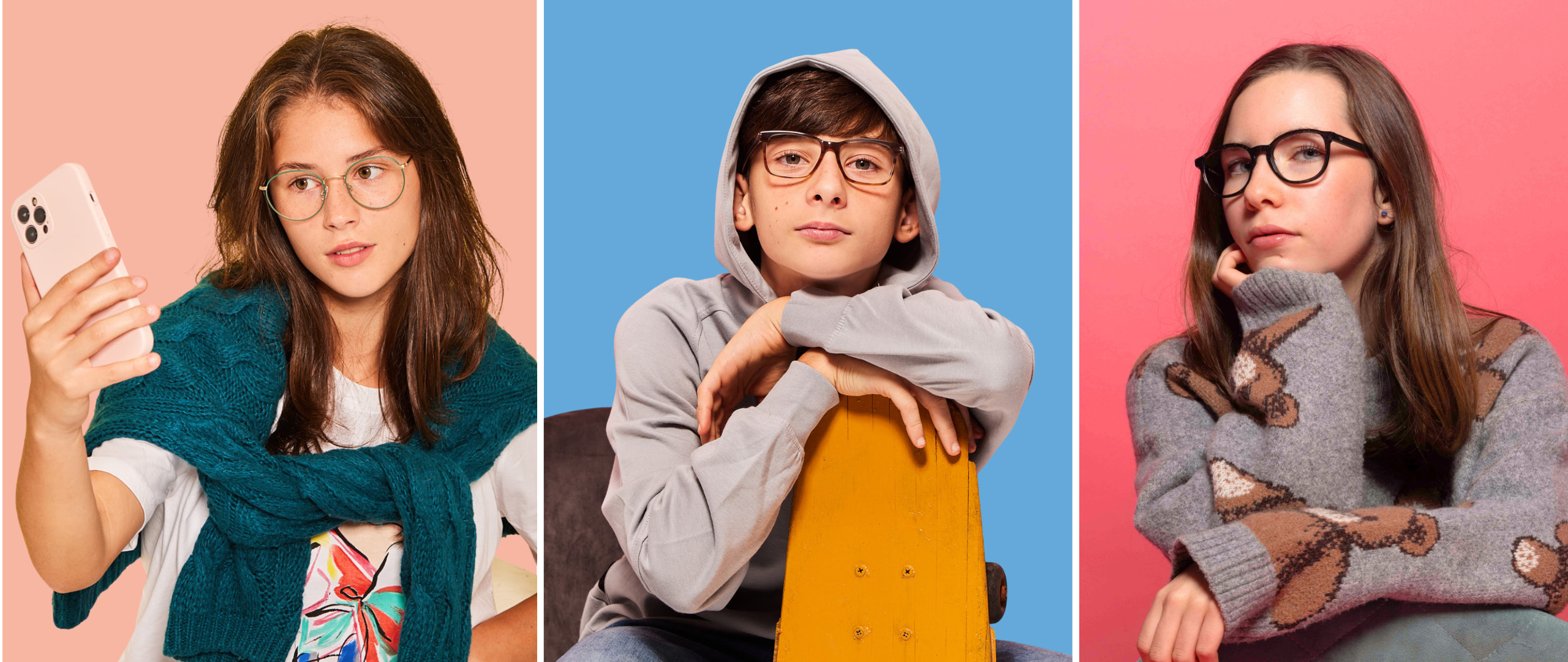
⏱️ 02:20 READING TIME
Summer is the season that invites us to change pace. Colors become brighter, days get longer, and the desire for lightness, freedom, and movement grows. Our habits change too, and often so do our visual needs.
For those who need vision correction, this is the time to ask: is it better to rely on contact lenses, or is it wiser (and more enjoyable) to rediscover the charm and practicality of glasses?
The truth is there’s no one-size-fits-all answer: the choice depends on who you are, what you do, and how you live your summer. Let’s take a moment to think about the advantages, limits, and possible combinations of these two options.
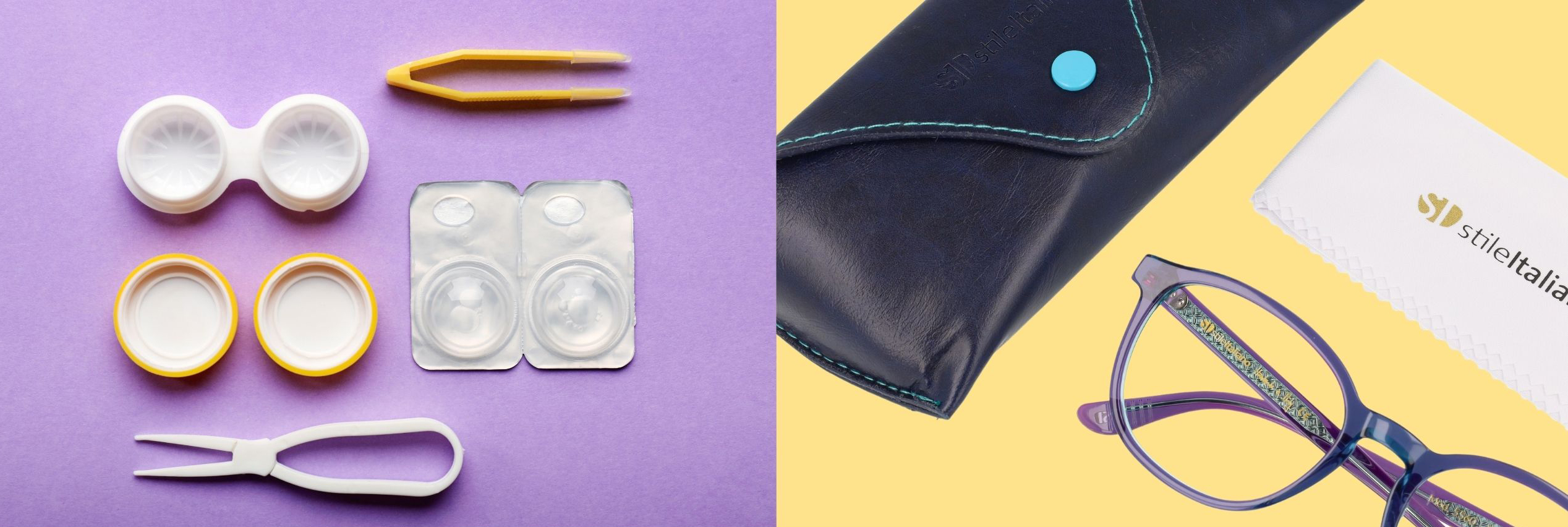
Contact lenses: invisible, light, perfect for active lifestyles
For those who love feeling free, practical, and dynamic, contact lenses are an ideal solution – especially on summer days when the sun invites us to head outdoors.
Imagine walking by the sea, playing sports, or wearing your favorite non-prescription sunglasses. Lenses let you do all this without constraints or bulk.
Strengths:
• They provide wide, natural vision with no frames around your gaze.
• Perfect for sports activities, cycling, or mountain hiking.
• Allow you to wear any type of trendy sunglasses.
Things to consider:
• Dry eyes: sun, wind, and air conditioning increase dryness, making lenses less comfortable.
• Management: require constant hygiene and care, which can be tricky when traveling.
• Caution: risk of infection increases at the beach or pool.
• No UV protection: always pair with sunglasses.
• No personality: they don’t enhance your face or tell your story.
💡 Tip: If you love practicality, consider daily lenses. They’re perfect for summer: wear them, toss them, no solutions or cases needed. Plus, they’re great to keep on hand as a “Plan B.”
Glasses: not just a tool, but a style accessory
Glasses have a charm of their own. They are not just a means to see better: they are part of who we are, an expression of our personality. In summer, they can also be allies in terms of protection and comfort.
Think about the annoyance of sand carried by the wind, the glare on a sunny terrace, or the sudden chill when entering an air-conditioned place: glasses protect and accompany you in all these situations.
Why choose them in summer:
• Protect from intense light, especially with photochromic or blue light filter lenses.
• Offer a physical barrier against dust, wind, and allergens.
• Require no complicated maintenance or direct eye handling.
• They are increasingly beautiful, lightweight, colorful — a design accessory that enhances every face.
Some useful tips:
• Avoid heavy materials if you’ll be spending a lot of time outdoors.
• Choose anti-reflective or photochromic lenses that darken in sunlight.
• Remember to protect your eyes with prescription sunglasses too: style and safety can go perfectly hand in hand.
Switching is the key; freedom, beauty, and functionality
The best choice is often not between glasses or lenses, but between glasses and lenses. Alternating is a smart strategy that lets you enjoy the advantages of both.
Glasses for working or relaxing during a cool terrace aperitif, lenses for trekking, cycling, exploring. The important thing is to listen to your lifestyle — and take care of your eyes mindfully.
Summer essentials: what to pack in your travel bag
✔️ A pair of lightweight prescription glasses, maybe in colorful acetate, comfortable and high-quality
🕶️ A good pair of sunglasses (even prescription) with UV filter
👁️ A kit with a few daily contact lenses, ideal for active days
🧴 A moisturizing solution or refreshing eye drops if you wear lenses
🧼 A microfiber cloth and a hard case to protect your glasses
In conclusion: summer is also vision
Summer is for seeing the world with fresh eyes. That’s why it’s worth taking a moment to reflect on what makes you feel good — not just see better.
Whether you choose glasses or contact lenses, the most important thing is feeling good in your eyes.
And if you want to do it in style, we’re here to accompany you.

⏱️ 01:50 READING TIME
Summer means freedom, light, relaxation. But if you’re still checking notifications, emails and social feeds under the sun, it might be time for a digital break.
You don’t need to disappear from social media or throw away your smartphone. You just need to choose, now and then, to be present.
And when you do it, do it with determination and self-care.
Because even beyond the screen, your gaze can speak. 👀

🔎 Signs you need a Digital Detox… for you and your eyes!
1️⃣ You scroll without realizing it
Ever pick up your phone to check the time and end up, 20 minutes later, on a Japanese cat influencer’s profile? You’re not alone. But maybe it’s time to take a step back.
👉 Style tip: Leave your phone at home and just take your sunglasses with you 🕶️
📍 SPOIL: your eyes deserve the real world.
2️⃣ You wake up and the first thing you do is look at a screen
If your morning starts with a blue screen instead of the sunshine, your body and mind are asking for a break.
🌿 Try starting your day with a walk in the park, sunglasses on and an offline playlist:
your brain will thank you.
3️⃣ You feel constantly “disconnected” – and not in a good way
More time online = less time for yourself.
If you feel tired, irritable or distracted, it might not just be stress: it could be digital overload.
😎 Rediscover the joy of slow time:
a book in the shade, a day at the beach, a face-to-face conversation.
Your eyes and mind will thank you.
4️⃣ You only take vacations “for the content””
If the only reason for your trip is “for the post,” something got lost along the way.
Summer is meant to be lived, not just shared.
📷 Remember: the best moments are the ones you don’t post because you’re too busy enjoying them!
5️⃣ Your eyes feel tired
Dry eyes, headaches, blurred vision?
Screen time doesn’t go easy on us.
👁️ Your visual system needs a break too.
🕶️ Protect your eyes with quality eyewear and, if you can, schedule a vision check-up.
👉 True beauty starts with your gaze, especially when you’re offline.
✨ Start your Digital Detox one step at a time, one gaze at a time.
You don’t need to give up technology – just learn to use it mindfully.
☀️ This summer, give yourself the luxury of truly living:
eyes on the horizon, light heart, phone on silent.
💡 Because when you turn off the screen, life turns on.
And your gaze – finally free – will tell your story better than any filter ever could! 🌅
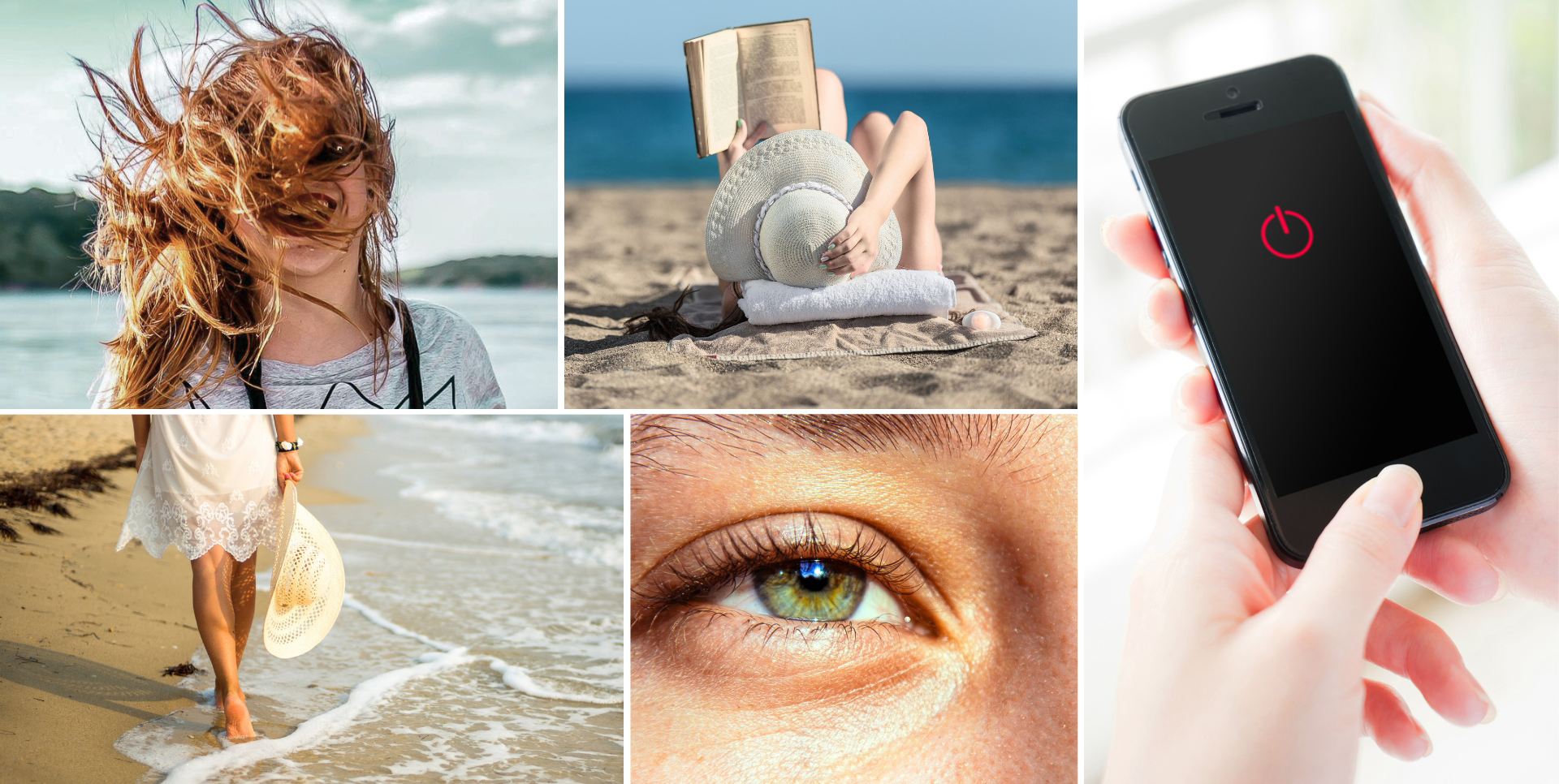
⏱️ 02:40 READING TIME
An emotional guide for parents who really want to listen.
Adolescence is a delicate time. It’s the season when the body changes, the mind drifts away from childhood, and other people’s gaze suddenly becomes a mirror in which we search for ourselves. Amid all this, starting to wear glasses may seem like a small detail. But for a boy or girl, it’s anything but.
Some outright refuse them, others hide them in their backpack as soon as they leave school, and some wear them only when no one’s watching. Often, behind these actions lies something deeper: the fear of being seen differently, of losing beauty, spontaneity, acceptance.
It’s understandable. Wearing glasses, at a time when identity is still a mosaic under construction, can feel like an imposed frame.
But with gentleness and attentive listening, this change can become an opportunity for growth, style, and self-awareness.
Discomfort exists. And it deserves respect.
Many parents, out of affection or protective instinct, tend to downplay things: “It’s nothing,” “You look great with glasses,” “Everyone wears them nowadays.”
Sincere words, of course. But often, they don’t help.
Because what a teenager feels has nothing to do with logic. It’s gut, skin, eyes avoiding the mirror. And it needs to be acknowledged before it can be corrected.
Instead of rushing to reassure, try listening:
“What don’t you like? When do you feel most uncomfortable? Want to tell me about it?”
Sometimes, just opening a space for listening can change the direction of rejection.
The mirror doesn’t lie, but it can smile.
One of the key moments is choosing the frame.
Something magical can happen here, if handled the right way.
Walking into a shop with your child and letting them try, mess up, laugh, and change their mind is a little rite of passage. It’s like saying: “This is your choice. I’m here to support you.”
A pair of glasses can make you feel more mature, more original, more authentic. Or simply, it can help you recognize yourself. And when a teenager looks in the mirror and finally sees themselves, with those glasses on their face that seem to say “this is me”, everything changes.
Words aren’t needed. Just the smile that lights up in their eyes.
Alternatives exist (and don’t diminish the value of glasses)
At certain times — a trip, a party, a sports event, an afternoon with friends — a teenager might want to set aside their glasses, not to hide, but to feel different, free, light.
Daily contact lenses are a discreet, practical, and above all respectful solution. They offer the possibility of choice. Of saying: yes today, not today.
Not as a permanent replacement, but as an ally on days when change is desired.
For many teens, simply having an option is already a relief.
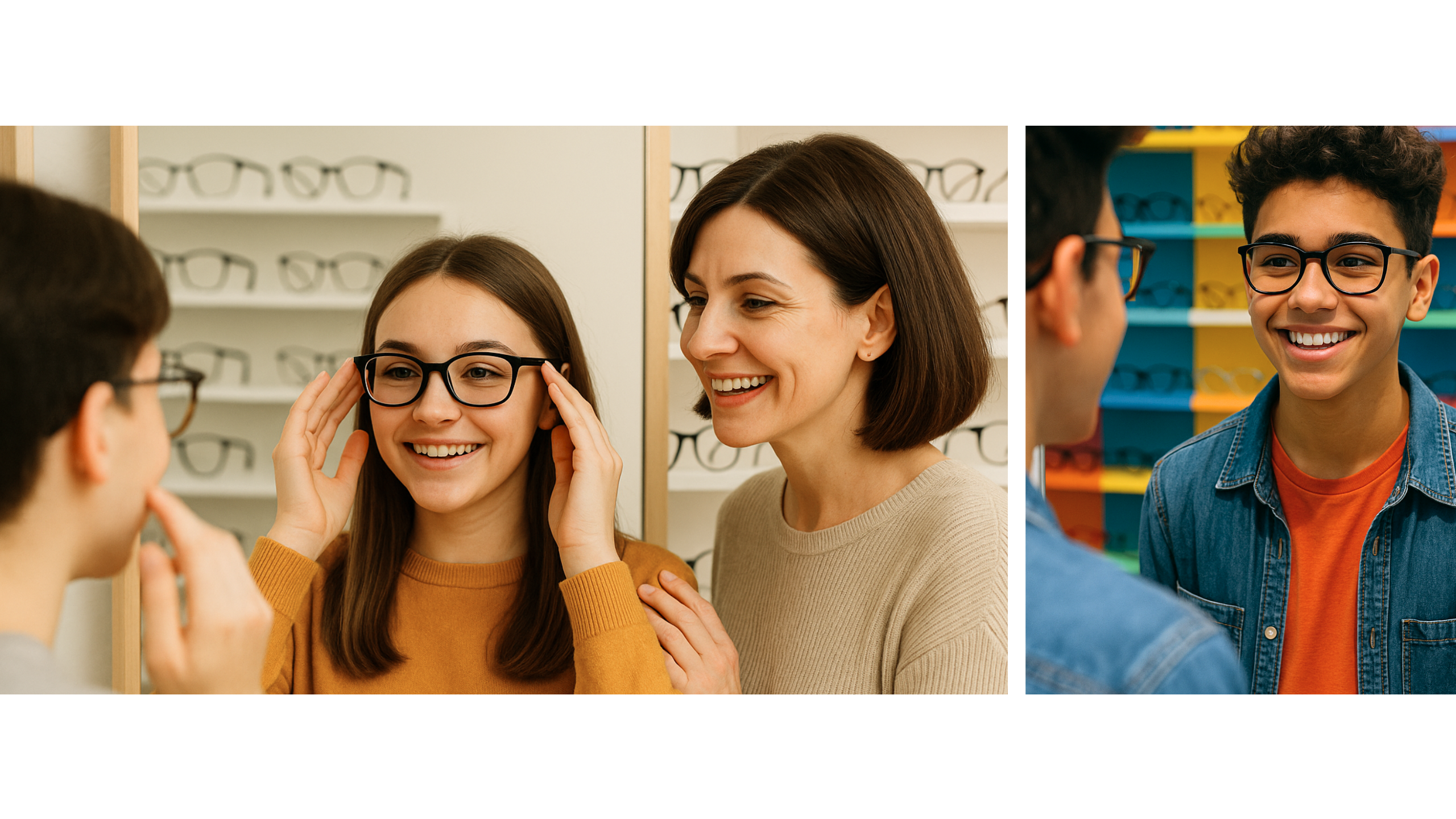
Not just beauty: glasses and style.
In the teenage world, glasses can become a signature.
A colorful frame tells a story of creativity. A minimalist model speaks of elegance. A square shape can convey strength, a round one lightness.
Helping your child find “their” glasses is like helping them find their voice in the chorus of their generation.
And there’s nothing more powerful for a teen than feeling aligned with what they feel inside and what they show on the outside.
Small gestures that change everything.
It might seem trivial, but there are things parents can do to make this phase easier. No need for long speeches. Just consistent gestures, attentive glances, and shared choices.
📍 Let them choose glasses like you’d choose shoes for a special event.
📍 Take photos with different frames, at home, calmly, away from pressure.
📍 Talk about glasses as style, not as necessity.
📍 Show them famous people, actors, athletes who wear glasses with pride.
📍 If it’s a girl starting to wear makeup, talk together about make-up for glasses wearers—not to hide the accessory but to enhance it.
📍 Let them experience glasses as something meaningful, not something imposed.
See better, feel better.
In the end, glasses help you see better. But if handled with care and heart, they can also help you feel better.
To feel seen, understood, supported.
To feel more confident reading, playing, going out, smiling.
To feel up to facing a world that looks at them—sometimes with judgment, often with admiration.
Because a teenager’s true strength… is recognizing themselves.
And yes, there will be days when those glasses get left on the nightstand. Others when they’re worn with pride. Still others when they’ll ask for contacts to feel free.
It’s all part of the journey.
We can’t expect our kids to accept everything right away.
We just have to be there—patient, present, ready to remind them that it’s not a pair of glasses that defines them.
It’s how they learn to look inside themselves.
